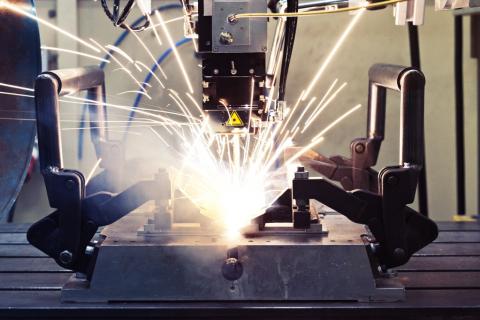03.09.2015
For a definitive breakthrough of lightweight materials in the automotive industry, new processes for manufacturing, testing and measuring are necessary. For this, steel-aluminum hybrid welds are of great interest, since they can be used for load-adapted, and at the same time lightweight components. Within the project LaserLeichter (Laser Lighter), the Laser Zentrum Hannover e.V. (LZH) is currently developing a laser welding process for joining three-dimensional structures made of steel and aluminum in a hybrid design.
One of the challenges in welding steel with aluminum is to avoid hard and brittle intermetallic phases in the welding seam. These phases can occur easily, since iron and aluminum do not combine well. The goal of the scientists at the LZH and their partners in the project LaserLeichter, is to control the welding process as much as possible. Therefore, different measuring methods will be assessed.
Establishing control during and after the running process
For one, the engineers will be testing a spectroscopic control of the welding depth, which measures the emissions of the plasma. During the ongoing process, the composition of the plasma indicates the welding depth, and allows to adapt the laser output accordingly. This control is already being evaluated at the LZH for flat welds, and will now be expanded to three-dimensional structures. Since the distance between the process zone and the measurement sensors inevitably changes in the course of the process, detecting the plasma emissions accurately is difficult. For optimal measurements, the spectrometer will be integrated into an innovative, scanner-based processing head.
Also, the scientists are testing a sensor made by the project partner Precitec GmbH & Co. KG, which can directly measure the depth of the keyhole (vapor capillary). Additionally, they are examining a thermal imaging process of the InfraTec GmbH, as well as a trailing nondestructive sample analysis using active thermal imaging from the inpro Innovationsgesellschaft für fortgeschrittene Produktionssysteme in der Fahrzeugindustrie mbH (inpro). The processes developed within the project are tested directly on demonstrators for the automotive industry, for example on a car body element or a battery case.
Apart from the LZH, Precitec GmbH & Co. KG, InfraTec GmbH and inpro, the following companies are working together in the joint project „Development of a laser-based joining technology for dissimilar lightweight constructions” (LaserLeichter): Volkswagen AG, Scherdel Marienberg GmbH, MATFEM Partnerschaft Dr. Gese & Oberhofer, LUNOVU Integrated Laser Solutions GmbH, Brandenburg University of Technology, and Fraunhofer-Institut für Werkstoff- und Strahltechnik (Fraunhofer IWS). Associated partners in the project are TRUMPF Laser GmbH, ASTOR Schneidwerkzeuge GmbH, ThyssenKrupp Steel Europe AG, Bond-Laminates GmbH and Sapa Aluminium Profile.
The joint project is coordinated by the Robert Bosch GmbH, and the project management organisation is the VDI Technologiezentrum GmbH. LaserLeichter is financed by the Federal Ministry of Education and Research (BMBF).
LaserLeichter is a joint project within the association „Photonic Processes and Tools for Resource Efficient Lightweight Construction“. This association is coordinated by the LZH and financed by the BMBF.














